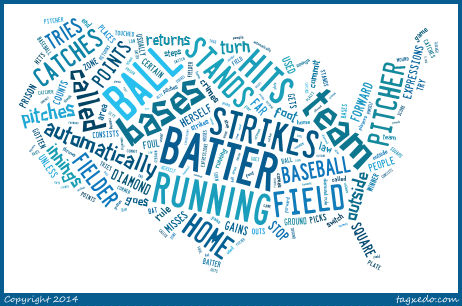Baseball Pitches
Posted: June 9, 2014 Filed under: lesson plan | Tags: baseball, observation, speaking, sports idioms, vocabulary 2 Comments

St Louis – Bush Stadium at Sunset by Joe Penniston is licensed under CCBY2.0
MAIN ACTIVITIES Vocabulary expansion, prediction, sports idioms
SUITABLE FOR Upper Intermediate (B2) and above
TEACHER’S NOTES (Click here for a pdf of the Teacher’s Notes.)
STEP 1
Show the class the word cloud below and ask them to name the sport.
STEP 2
Divide the class into four groups – A, B, C and D – and organise the groups in a rough circle around the room. There must be at least one person in each group who has a mobile phone or tablet with an internet connection. If you have a big class, you can make eight groups. Display this image and ask them to tell each other what they know about baseball – its vocabulary and its rules. They can use mobiles or dictionaries to look things up.
STEP 3
Ask each group to nominate one member, who must then go and “visit” the next group in a clockwise direction. The visitor and the group compare ideas. Afterwards, the visitors return to their respective groups and give some feedback.
STEP 4
Display this page from the Oxford Advanced American Dictionary so that groups can check their predictions.
STEP 5
Tell students that it’s traditional in baseball to have a ceremonial opening pitch, usually performed by someone famous or to celebrate some special event. Tell them that they are going to watch a different YouTube video each showing ceremonial pitches which are famous for being unusual in some way. Each group has to watch their video and work out how to describe exactly what happened in English.
Get each group to watch one of the videos below. In class, you can do this by getting students to look for the video on YouTube using the descriptions in italics as follows:
Group A cirque du soleil baseball pitch
Group B Max Ashton baseball pitch
Group C Shin Soo-Ji baseball pitch
Group D Zombies baseball pitch
STEP 6
Give students time (and some help!) to come up with accurate descriptions of the scene.
STEP 7
Once they’re ready, reorganise the class into four new groups where there is a representative of each original group in each new one, i.e. the new groups are made up of at least one person each from A, B, C and D. There must be a mobile phone or tablet with an internet connection in each new group.
STEP 8
Each person now takes it in turns to show the opening scene of their original video, being careful to stop it before the ball is thrown. The others have to guess what happens next. The person who showed the video then gives a point to the person who was closest before describing verbally what happens in the video without showing it.
STEP 9
Once all the opening scenes have been seen, they then watch each full video to see what actually happens. Now the group have to decide who gets a point for having given the most accurate verbal description.
STEP 10
Ask students which video they liked best and why. To round off the lesson, ask students to use their mobiles or a dictionary to first figure out the meanings of these questions – all containing sporting idioms – and then answer them.

